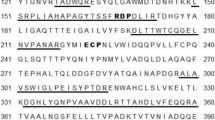Abstract
A carbohydrate-binding module from family 13 (CBM13), appended to the catalytic domain of endo-1,3-β-glucanase from Cellulosimicrobium cellulans, was overexpressed in E. coli, and its interactions with β-glucans, laminarin and laminarioligosaccharides, were analyzed using surface plasmon resonance biosensor and isothermal titration calorimetry. The association constants for laminarin and laminarioligosaccharides were determined to be approximately 106 M−1 and 104 M−1, respectively, indicating that 2 or 3 binding sites in the α-, β-, and γ-repeats of CBM13 are involved in laminarin binding in a cooperative manner. The binding avidity is approximately 2-orders higher than the monovalent binding affinity. Mutational analysis of the conserved Asp residues in the respective repeats showed that the α-repeat primarily contributes to β-glucan binding. A Trp residue is predicted to be exposed to the solvent only in the α-repeat and would contribute to β-glucan binding. The α-repeat bound β-glucan with an affinity of approximately 104 M−1, and the other repeats additionally bound laminarin, resulting in the increased binding avidity. This binding is unique compared to the recognition mode of another CBM13 from Streptomyces lividans xylanase.





Similar content being viewed by others
Abbreviations
- CBM:
-
Carbohydrate-binding module
- SPR:
-
Surface plasmon resonance
- ITC:
-
Isothermal titration calorimetry
- His-tag:
-
Polyhistidine-tag
- PCR:
-
Polymerase chain reaction
- Ni-NTA:
-
Ni-nitrilotriacetic acid
- SDS-PAGE:
-
Sodium dodecyl sulfate-polyacrylamide gel electrophoresis
- CD:
-
Circular dichroism
- DLS:
-
Dynamic light scattering
References
Boraston, A.B., Bolam, D.N., Gilbert, H.J., Davies, G.J.: Carbohydrate-binding modules: fine-tuning polysaccharide recognition. Biochem. J. 382, 769–781 (2004)
Shoseyov, O., Shani, Z., Levy, I.: Carbohydrate binding modules: biochemical properties and novel applications. Microbiol. Mol. Biol. Rev. 70, 283–295 (2006)
Ferrer, P.: Revisiting the Cellulosimicrobium cellulans yeast-lytic β-1,3-glucanases toolbox: a review. Microb. Cell Fact. 5, 10 (2006)
Tanabe, Y., Pang, Z., Oda, M.: Cloning and sequencing of endo-1,3-β-glucanase from Cellulosimicrobium cellulans. J. Biol. Macromol. 8, 60–63 (2008)
Notenboom, V., Boraston, A.B., Williams, S.J., Kilburn, D.G., Rose, D.R.: High-resolution crystal structures of the lectin-like xylan binding domain from Streptomyces lividans xylanase 10A with bound substrates reveal a novel mode of xylan binding. Biochemistry 41, 4246–4254 (2002)
Fujimoto, Z., Kuno, A., Kaneko, S., Kobayashi, H., Kusakabe, I., Mizuno, H.: Crystal structures of the sugar complexes of Streptomyces olivaceoviridis E-86 xylanase: sugar binding structure of the family 13 carbohydrate binding module. J. Mol. Biol. 316, 65–78 (2002)
Fujimoto, Z., Kaneko, S., Kuno, A., Kobayashi, H., Kusakabe, I., Mizuno, H.: Crystal structures of decorated xylooligosaccharides bound to a family 10 xylanase from Streptomyces olivaceoviridis E-86. J. Biol. Chem. 279, 9606–9614 (2004)
Arnold, K., Bordoli, L., Kopp, J., Schwede, T.: The SWISS-MODEL Workspace: a web-based environment for protein structure homology modelling. Bioinformatics 22, 195–201 (2006)
Boraston, A.B., Tomme, P., Amandoron, E.A., Kilburn, D.G.: A novel mechanism of xylan binding by a lectin-like module from Streptomyces lividans xylanase 10A. Biochem. J. 350, 933–941 (2000)
Schärpf, M., Connelly, G.P., Lee, G.M., Boraston, A.B., Warren, R.A., McIntosh, L.P.: Site-specific characterization of the association of xylooligosaccharides with the CBM13 lectin-like xylan binding domain from Streptomyces lividans xylanase 10A by NMR spectroscopy. Biochemistry 41, 4255–4263 (2002)
Tanaka, S., Aketagawa, J., Takahashi, S., Shibata, Y., Tsumuraya, Y., Hashimoto, Y.: Activation of a limulus coagulation factor G by (1→3)-β-D-glucans. Carbohydr. Res. 218, 167–174 (1991)
Oda, M., Azuma, T.: Reevaluation of stoichiometry and affinity/avidity in interactions between anti-hapten antibodies and mono- or multi-valent antigens. Mol. Immunol. 37, 1111–1122 (2000)
Ho, S.N., Hunt, H.D., Horton, R.M., Pullen, J.K., Pease, L.R.: Site-directed mutagenesis by overlap extension using the polymerase chain reaction. Gene 77, 51–59 (1989)
Alahuhta, M., Xu, Q., Bomble, Y.J., Brunecky, R., Adney, W.S., Ding, S.Y., Himmel, M.E., Lunin, V.V.: The unique binding mode of cellulosomal CBM4 from Clostridium thermocellum cellobiohydrolase A. J. Mol. Biol. 402, 374–387 (2010)
Schouppe, D., Rougé, P., Lasanajak, Y., Barre, A., Smith, D.F., Proost, P., Van Damme, E.J.: Mutational analysis of the carbohydrate binding activity of the tobacco lectin. Glycoconj. J. 27, 613–623 (2010)
Salazar, O., Molitor, J., Lienqueo, M.E., Asenjo, J.A.: Overproduction, purification, and characterization of β-1,3-glucanase type II in Escherichia coli. Protein Expr. Purif. 23, 219–225 (2001)
Li, N., Shi, P., Yang, P., Wang, Y., Luo, H., Bai, Y., Zhou, Z., Yao, B.: A xylanase with high pH stability from Streptomyces sp. S27 and its carbohydrate-binding module with/without linker-region-truncated versions. Appl. Microbiol. Biotechnol. 83, 99–107 (2009)
Tanabe, Y., Oda, M.: Molecular characterization of endo-1,3-β-glucanase from Cellulosimicrobium cellulans: effects of carbohydrate-binding module on enzymatic function and stability. BBA - Proteins Proteomics 1814, 1713–1719 (2011)
Acknowledgments
The authors thank Mr. Takahiro Maruno of Osaka University and Prof. Yuji Kobayashi of Osaka University of Pharmaceutical Sciences for technical support and helpful discussion. This work was partly performed under the Joint Usage/Research Program of Medical Research Institute, Tokyo Medical and Dental University.
Author information
Authors and Affiliations
Corresponding author
Rights and permissions
About this article
Cite this article
Tamashiro, T., Tanabe, Y., Ikura, T. et al. Critical roles of Asp270 and Trp273 in the α-repeat of the carbohydrate-binding module of endo-1,3-β-glucanase for laminarin-binding avidity. Glycoconj J 29, 77–85 (2012). https://doi.org/10.1007/s10719-011-9366-x
Received:
Revised:
Accepted:
Published:
Issue Date:
DOI: https://doi.org/10.1007/s10719-011-9366-x




